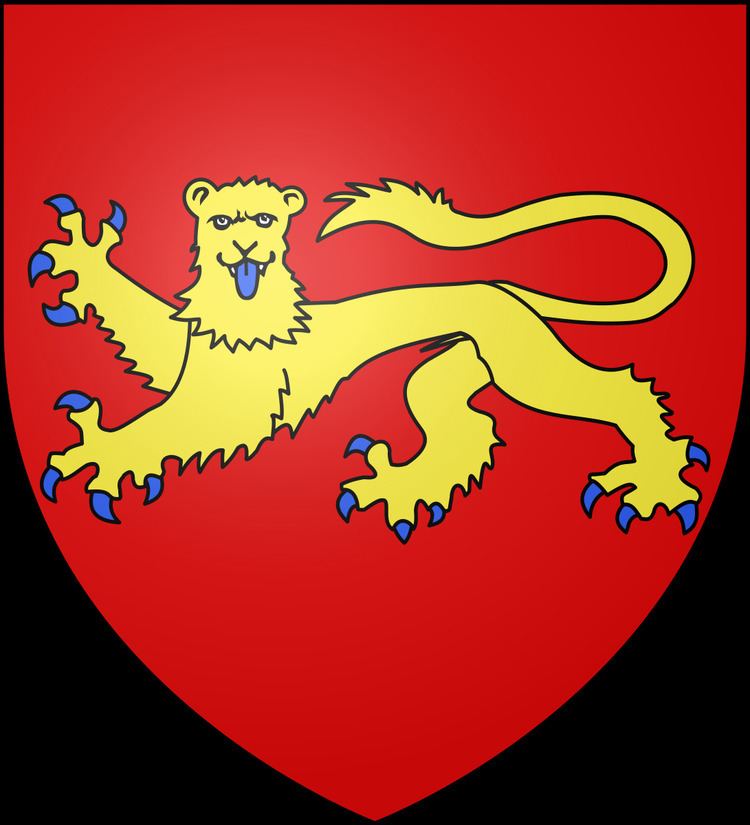The House of Laval is a family of barons, later counts, coming from the town of Laval, located in Northwestern France, part of the province of Maine before the French Revolution. The Laval were one of the most powerful families of Maine during the Middle Ages and also had a presence in Brittany, where their prestige was similar to the one of the Rohan. The House of Laval played a significant role in Breton history and during the Hundred Years War and the French Wars of Religion. They also favored the French Renaissance in Northwestern France, building several châteaux. The last male heir died during the 17th century, and his possessions went to the House of La Trémoille.
François de Laval was the first Roman Catholic bishop of Quebec; the city of Laval, Quebec, and the Université Laval were named after him.
Branches and titles
The House of Laval appeared during the first quarter of the 11th century. Its origins are unclear and the first mentioned baron is Guy I. The direct branch is extinct in 1211, after the death of Guy VI. His sister, Edme, had previously married Matthieu II de Montmorency with a contract stipulating that her first son should take the Laval surname and arms.
The branch of Montmorency-Laval dies in 1412 with Guy XII. His heiress, Anne, had married Jean de Montfort with a contract similar to Edme's one. Hence, her heirs took the name of Laval.
The branch of Montfort-Laval starts with Jean de Montfort, nicknamed Guy XIII of Laval, who dies in 1415, and ends with Guy XVII in 1547.
The branch of Rieux-Laval starts with Louis de Sainte-Maure, who married the granddaughter of Guy XVI of Laval. This branch dies with Guy XX, killed in Hungary in 1605.
The possessions of Laval go the La Trémoïlle, who stop the medieval tradition according which all the counts of Laval have to be called "Guy".
Guy V de Laval (d 1210) married Avoise de Craon and siredGuy VI (d 1211) who died childlessEmma (c1200-1264, sister of Guy VI) married Mathieu II de Montmorency and gave birth toGuy VII (d 1267) who married Philippa de Vitre and siredGuy VIII (d 1295), who married Isabelle Beaumont and siredGuy IX (d 1333), who married Beatrix de Gavre and siredGuy X (d 1347), who married Beatrix of Brittany (daughter of Arthur II) and siredGuy XI (d 1348) andGuy XII (d 1412), who married Jeanne de Laval (a second cousin, descended from Guy VIII). His son Guy predeceased him in 1403. The title then passed toAnne (d 1466, daughter of Guy XII), who married Jean de Montfort, making him Guy XIII de Laval. They had several sons, including Guy XIV de LavalGuy XIV de Laval (d 1486), who married Isabella of Brittany and siredGuy XV (d 1501)Jean de Laval (brother of Guy XV) siredGuy XVI (d 1531), who married Charlotte of Naples and Anne de Montmorency. By Anne, he siredGuy XVII (d 1547)Catherine (daughter of Guy XVI and Charlotte) had 2 daughters:Renee (d 1567), who reigned as Guyonne de Laval (counting as the 18th) andClaude (d 1561), who gave birth toGuy XIX (d 1586), who married Anne d'Alegre and siredGuy XX de Laval (d 1605), who was the last of his line, and the last Count to take the name of Guy.Gilles de Montmorency-Laval (1404–1440), companion-in-arms of Joan of Arc and inspiration for the "Bluebeard" by Charles PerraultAndré de Laval-Montmorency (c. 1408 – 1485), Marshal of FranceJeanne de Laval, Queen consort of Naples and SicilyJean de Laval, count of Châteaubriant and Governor of Brittany, who was married to Françoise de FoixAnne de Laval (1505–1554), who was a pretender to the throne of Naples and ancestor to kings of France and BelgiumHenri II de Montmorency (1595–1632), military commanderSaint-François de Montmorency-Laval, first Bishop of QuebecLouis-Joseph de Montmorency-Laval, Bishop of MetzMathieu de Montmorency (1767–1826), statesman during the French Revolution and Bourbon Restoration
